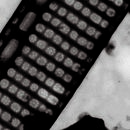Biology
provided by Diatom LifeDesk
Pseudo-nitzschia calliantha is a domoic-acid-producing, pennate diatom. However, not all strains of this species are toxin-producers. Compared to other Pseudo-nitzschia species it does not produce high levels of domoic acid. It is often found in coastal regions and can form monospecific blooms.
- license
- cc-by-nc
- copyright
- Thessen, Anne
Diagnostic Description
provided by Diatom LifeDesk
From Lundholm et al. 2003: Overlapping cells in colonies. Cells linear in valve view; tapering part of the valve toward the tips very short, in girdle view linear. Transapical axis of valves 1.3-1.8 microns, apical axis 41-98 microns. Eccentric raphe divided in the middle by a central nodule. The fibulae regularly spaced, 15-22 in 10 microns, interstriae 34-39 in 10 microns. Striae with one row of round to square poroids, 4-6 poroids in 1 micron. Hymen of poroids perforated by 7-10 sectors. Valve mantle structured as valve face, one poroid high. Cingulum with three open bands, all containing 42-48 striae in 10 microns. Each stria 2-3 poroids wide and a varying number of poroids high, the number decreasing in abvalvar direction.
- license
- cc-by-nc
- copyright
- Thessen, Anne
Distribution
provided by Diatom LifeDesk
Pseudo-nitzschia calliantha is found in tropical and temperate coastal waters. It has a more or less cosmopolitan distribution. It is often abundant in the Mediterranean Sea. For a summary of P. calliantha reports see Lundholm et al. (2003).
- license
- cc-by-nc
- copyright
- Thessen, Anne
Ecology
provided by Diatom LifeDesk
P. calliantha can form monospecific blooms in response to seasonal changes in the water column and nutrient run-off from land. They bloom often in response to seasonal run-off and thus can be correlated with nitrogen, phosphorus, temperature and salinity (Spatharis et al. 2009, Buric et al. 2008, Spatharis et al. 2007a, b).
- license
- cc-by-nc
- copyright
- Thessen, Anne
General Description
provided by Diatom LifeDesk
P. calliantha forms the step-chains characteristic of the genus. Cells are long and thin. Each stria contains one row of round to square poroids with a hymen perforated in a flower pattern. For a summary of P. calliantha morphology see Lundholm et al. (2003).
- license
- cc-by-nc
- copyright
- Thessen, Anne
Management
provided by Diatom LifeDesk
Pseudo-nitzschia calliantha has caused domoic acid contamination of shellfish in Atlantic Canada.
- license
- cc-by-nc
- copyright
- Thessen, Anne
Physiology
provided by Diatom LifeDesk
A Canadian isolate of P. calliantha had a maximum specific growth rate of 0.74 ± 0.02 and a maximum pH for growth of 9.0 in the laboratory (100 micromolar photons m-2s-1 and 15°C; Lundholm et al. 2004).
- license
- cc-by-nc
- copyright
- Thessen, Anne
Reproduction
provided by Diatom LifeDesk
Pseudo-nitzschia calliantha can reproduce asexually through cell division and sexually to restore cell size (Davidovich & Bates 1998). Reproduction in P. calliantha is heterothallic (Amato et al. 2007).
- license
- cc-by-nc
- copyright
- Thessen, Anne
Size
provided by Diatom LifeDesk
The average cell volume of a Canadian isolate was 250 ± 12 cubic microns (Lundholm et al. 2004).
- license
- cc-by-nc
- copyright
- Thessen, Anne
Distribution
provided by World Register of Marine Species
Probably cosmopolitan. It has been recorded from both cold water and warm water areas and from both hemispheres.
- Stonik I.V., Orlova T.Y., Lundholm N. 2011. Diversity of Pseudo-nitzschia H. Peragallo from the western North Pacific. Diatom Research 26:121-134
- Lelong A, Hegaret H, Soudant P, Bates S.S. 2012. Pseudo-nitzschia (Bacillariophyceae) species, domoic acid and amnesic shellfish poisoning: revisiting previous paradigms. Phycologia 51:168-216.
- Lundholm, N., Moestrup, Ø., Hasle, G.R. & Hoef-Emden, K. (2003). A study of the Pseudo-Nitzschia pseudodelicatissima complex (Bacillariophyceae): What is P. pseudodelicatissima?. Journal of Phycology. 39: 797-813.
- license
- cc-by-4.0
- copyright
- WoRMS Editorial Board
Harmful effect
provided by World Register of Marine Species
Strains from e.g. Canada, Chile, Denmark and Tunisia has been found to produce domoic acid. The amounts of DA vary from undetectable up to 0.221 pg cell-1.
Trainer, V.L., Wells, M.L., Cochlan, W.P., Trick, C.G., Bill, B.D., Baugh, K.A., Beall, B.F., Herndon, J. & Lundholm, N. 2009. An ecological study of a massive bloom of toxigenic Pseudo-nitzschia cuspidata off the Washington State coast
- license
- cc-by-4.0
- copyright
- WoRMS Editorial Board
Morphology
provided by World Register of Marine Species
P. calliantha belong to the morphological P. pseudodelicatissima-complex, comprising species with narrow valves (ca. 1.5-2.5µm), a central nodule and uniseriate striae. P. calliantha is mainly characterised by * narrow valve width: 1.3-1.8µm * poroids with several sectors (4-10)
- Lundholm, N.; Bates, S. S.; Baugh, K. A.; Bill, B. D.; Connell, L. B.; Léger, C.; Trainer, V. L. (2012). CRYPTIC AND PSEUDO-CRYPTIC DIVERSITY IN DIATOMS-WITH DESCRIPTIONS OF PSEUDO-NITZSCHIA HASLEANA SP. NOV. AND P. FRYXELLIANA SP. NOV.1. Journal of Phycology. 48(2): 436-454.
- Lim, H.-C.; Leaw, C.-P.; Su, S. N.-P.; Teng, S.-T.; Usup, G.; Mohammad-Noor, N.; Lundholm, N.; Kotaki, Y.; Lim, P.-T. (2012). MORPHOLOGY AND MOLECULAR CHARACTERIZATION OFPSEUDO-NITZSCHIA(BACILLARIOPHYCEAE) FROM MALAYSIAN BORNEO, INCLUDING THE NEW SPECIESPSEUDO-NITZSCHIA CIRCUMPORASP. NOV. Journal of Phycology. 48(5): 1232-1247.
- Lundholm, N., Moestrup, Ø., Hasle, G.R. & Hoef-Emden, K. (2003). A study of the Pseudo-Nitzschia pseudodelicatissima complex (Bacillariophyceae): What is P. pseudodelicatissima?. Journal of Phycology. 39: 797-813.
- license
- cc-by-4.0
- copyright
- WoRMS Editorial Board

